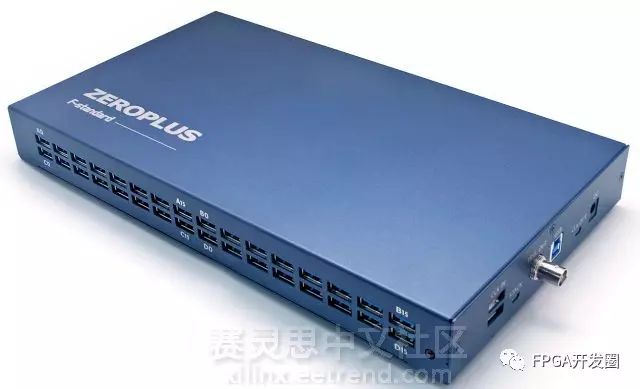The most commonly used tool in the development of electronic products is the oscilloscope. However, with the advancement of microprocessors such as ARM, X86, MIPS architectures, GPUs, deep learning processors, and the rapid growth of smart hardware, various logical bugs in hardware are frequently encountered. When issues arise with various interfaces of SoC (System on Chip) such as SPI, USB, I2C, UART, the oscilloscope can barely cope. When measuring bus signals like AXI, PCIe, or needing to measure many pin signals on a chip or board simultaneously, the oscilloscope can only sigh: “I can’t do it.” At this point, a specialized device is needed, which is the logic analyzer. It is an instrument that collects and displays digital signals from the test device using a clock, primarily used for timing determination. Electronic engineers need to analyze the logical relationships of digital systems. The logic analyzer not only solves the problem of insufficient input channels of the oscilloscope but also provides more powerful triggering and analysis functions. For digital circuit development systems, the logic analyzer is an excellent tool.

Logic analyzers can be roughly divided into standalone and card-style types. Standalone logic analyzers integrate all testing software, computing management components, and more into a single instrument. Card-style virtual logic analyzers, on the other hand, need to be used in conjunction with a computer, with the display separated from the main unit. The LAP-F1 launched by ZeroPlus is a card-style logic analyzer that uses the Xilinx Kintex-7 160T FPGA. This product features 64 channels, with a maximum sampling rate of 1G samples/second for timing analysis and a frequency of up to 200MHz for state analysis. It can perform a series of functions from signal capture and information storage in its DDR3-1600MHz memory to triggering and protocol decoding, and presents the results graphically to developers, who can analyze whether errors occur according to the protocol based on the signals. With the powerful Xilinx Kintex-7 series products, this logic analyzer has lower power consumption and higher digital signal processing capabilities, supporting measurements and analysis of mainstream PCIe Gen3 and 10 Gigabit Ethernet digital signals, as well as logical signal measurements and analysis for flat panel displays and video IP modules. The Xilinx FPGA not only provides robust power consumption validation for fully customized chips but also exhibits strong performance in the debugging process of chip digital systems, making it a versatile tool.
The advantages of the logic analyzer include the ability to simultaneously detect multiple inputs, comprehensive triggering functions, and powerful analysis capabilities. This is primarily reflected in observing whether there are glitches, interference, and whether the frequency is correct in the measured waveform, performing timing analysis on the measured signals, eliminating operational conflicts and timing coordination, analyzing bus signals or high-level protocols to accelerate development progress, and using triggering functions to capture errors, thereby eliminating hidden errors in the system and increasing product reliability. Such a multitude of functions requires a powerful brain for data analysis and processing, and the Xilinx FPGA series products will develop even better products to meet the needs of currently mainstream buses and various high-performance peripheral interfaces, providing more comprehensive, multi-layered, and wide-ranging services for the development process of more hardware products.


FPGA Memory Recommendations (Using Vivado Design Suite)
The 100G Era of Data Centers is Here! Virtex UltraScale+ FPGA Accelerates Core Network!
A Novel System Architecture: Kintex-7 FPGA + Nvidia TX2 = 16 Channel High-Speed ADC Data Acquisition System
Xilinx, Arm, Cadence, and TSMC Announce the World’s First 7nm CCIX Test Chip
Good News for Embedded Developers, Huawei FPGA Accelerated Cloud Server is Here!
[Expert Q&A] I Can’t Simulate MicroBlaze MCS in My IPI Design
Shocking! nvNITRO NVMe Ultra-High-Speed Accelerator Card Based on Xilinx Kintex UltraScale
Python is the Fastest Growing Mainstream Programming Language
Xilinx Helps Huawei FPGA Accelerated Cloud Server Achieve 10x Improvement in Machine Learning, Data Analysis, and Video Processing Performance
Hardware Cloud? Yes, Aldec Launches HES Hardware Cloud Based on Xilinx FPGA
How to Use Programmable Logic for Button Input Debouncing
Local Oscillator Leakage – A Troublesome Issue in Zero Intermediate Frequency Architecture
Xilinx Developer Conference Paper Call is Now Open!
Performance Boost of 350%-400%! Xilinx DSP Slices Realize SDF Pipeline FFT Core
Optimize Design Performance with Xilinx Tools and InTime on Amazon EC2 Cloud
Step-by-Step Guide to Using FPGA Memory with DRAM
Baidu Cloud RSA Decryption Acceleration Service
[Download] 8-Bit Dot Product Acceleration
$59 WiFi/Bluetooth Pmod Module Murata 1DX Launched!
A New Type of Industrial 4.0 Ethernet Kit Based on Zynq

